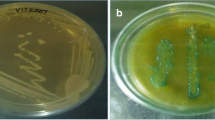Abstract
Unlike dairy lactic acid bacteria, Lactobacillus brevis cannot ferment milk. We characterized the lactose utilization by L. brevis KB290. In a carbohydrate fermentation assay using API 50 CHL, we showed during 7 days L. brevis did not ferment lactose. L. brevis grew to the stationary phase in 2 weeks in MRS broth containing lactose as the carbon source. L. brevis slowly consumed the lactose in the medium. L. brevis hydrolyzed lactose and a lactose analog, o-nitrophenyl-β-d-galactopyranoside (ONPGal). This β-galactosidase activity for ONPGal was not repressed by glucose, galactose, fructose, xylose, or maltose showing the microorganism may not have carbon catabolite repression. We purified the L. brevis β-galactosidase using ammonium sulfate precipitation and several chromatographies. The enzyme’s molecular weight is estimated at 72 and 37 kDa using SDS-PAGE analysis. The N-terminal amino acid sequence of the larger protein was 90 % similar to the sequence of the putative β-galactosidase (YP_796339) and the smaller protein was identical to the sequence of the putative β-galactosidase (YP_796338) in L. brevis ATCC367. This suggests the enzyme is a heterodimeric β-galactosidase. The specific activity of the purified enzyme for lactose is 55 U/mg. We speculate inhibition of lactose transport delays the lactose utilization in L. brevis KB290.





Similar content being viewed by others
References
Carey AT, Smith DL, Harrison E, Bird CR, Gross KC, Seymour GB, Tucker GA (2001) Down-regulation of a ripening-related β-galactosidase gene (TBG1) in transgenic tomato fruits. J Exp Bot 52:663–668
Citti JE, Sandine WE, Elliker PR (1965) β-Galactosidase of Streptococcus lactis. J Bacteriol 89:937–942
Fuller R (1989) Probiotics in man and animals. J Appl Bacteriol 66:365–378
Görke B, Stülke J (2008) Carbon catabolite repression in bacteria: many ways to make the most out of nutrients. Nat Rev Microbiol 6:613–624
Iqbal S, Nguyen TH, Nguyen TT, Maischberger T, Haltrich D (2010) β-Galactosidase from Lactobacillus plantarum WCFS1: biochemical characterization and formation of prebiotic galacto-oligosaccharides. Carbohydr Res 345:1408–1416
Kandler O (1983) Carbohydrate metabolism in lactic acid bacteria. Antonie Van Leeuwenhoek 49:209–224
Kawahara T, Otani H (2006) Stimulatory effect of lactic acid bacteria from commercially available Nozawana-zuke pickle on cytokine expression by mouse spleen cells. Biosci Biotechnol Biochem 70:411–417
Kim JH, Block DE, Mills DA (2010) Simultaneous consumption of pentose and hexose sugars: an optimal microbial phenotype for efficient fermentation of lignocellulosic biomass. Appl Microbiol Biotechnol 88:1077–1085
Kim JH, Shoemaker SP, Mills DA (2009) Relaxed control of sugar utilization in Lactobacillus brevis. Microbiology 155:1351–1359
Kishi A, Uno K, Matsubara Y, Okuda C, Kishida T (1996) Effect of the oral administration of Lactobacillus brevis subsp. coagulans on interferon-α producing capacity in humans. J Am Coll Nutr 15:408–412
Kotrba P, Inui M, Yukawa H (2001) Bacterial phosphotransferase system (PTS) in carbohydrate uptake and control of carbon metabolism. J Biosci Bioeng 92:502–517
Maischberger T, Leitner E, Nitisinprasert S, Juajun O, Yamabhai M, Nguyen TH, Haltrich D (2010) β-Galactosidase from Lactobacillus pentosus: purification, characterization and formation of galacto-oligosaccharides. Biotechnol J 5:838–847
Mayo B, Aleksandrzak-Piekarczyk T, Fernández M, Kowalczyk M, Álvarez-Martín P, Bardowski J (2010) Updates in the metabolism of lactic acid bacteria. In: Mozzi F, Raya RR, Vignolo GM (eds) Biotechnology of lactic acid bacteria: novel applications. Wiley-Blackwell, Ames, pp 3–33
Murooka Y, Yamshita M (2008) Traditional healthful fermented products of Japan. J Ind Microbiol Biotechnol 35:791–798
Nguyen TH, Splechtna B, Steinböck M, Kneifel W, Lettner HP, Kulbe KD, Haltrich D (2006) Purification and characterization of two novel β-galactosidases from Lactobacillus reuteri. J Agric Food Chem 54:4989–4998
Nguyen TH, Splechtna B, Krasteva S, Kneifel W, Kulbe KD, Divne C, Haltrich D (2007) Characterization and molecular cloning of a heterodimeric β-galactosidase from the probiotic strain Lactobacillus acidophilus R22. FEMS Microbiol Lett 269:136–144
Nigatu A, Ahrné S, Molin G (2000) Temperature-dependent variation in API 50 CH fermentation profiles of Lactobacillus species. Curr Microbiol 41:21–26
Nobuta Y, Inoue T, Suzuki S, Arakawa C, Yakabe T, Ogawa M, Yajima N (2009) The efficacy and the safety of Lactobacillus brevis KB290 as a human probiotics. Int J Probiotics Prebiotics 4:263–270
Romano AH, Brino G, Peterkofsky A, Reizer J (1987) Regulation of β-galactoside transport and accumulation in heterofermentative lactic acid bacteria. J Bacteriol 169:5589–5596
Rönkä E, Malinen E, Saarela M, Rinta-Koski M, Aarnikunnas J, Palva A (2003) Probiotic and milk technological properties of Lactobacillus brevis. Int J Food Microbiol 83:63–74
Saier MH Jr, Chauvaux S, Cook GM, Deutscher J, Paulsen IT, Reizer J, Ye JJ (1996) Catabolite repression and inducer control in gram-positive bacteria. Microbiology 142:217–230
Schwab C, Sørensen KI, Gänzle MG (2010) Heterologous expression of glycoside hydrolase family 2 and 42 β-galactosidases of lactic acid bacteria in Lactococcus lactis. Syst Appl Microbiol 33:300–307
Titgemeyer F, Hillen W (2002) Global control of sugar metabolism: a gram-positive solution. Antonie Van Leeuwenhoek 82:59–71
van den Bogaard PT, Kleerebezem M, Kuipers OP, de Vos WM (2000) Control of lactose transport, β-galactosidase activity, and glycolysis by CcpA in Streptococcus thermophilus: evidence for carbon catabolite repression by a non-phosphoenolpyruvate-dependent phosphotransferase system sugar. J Bacteriol 182:5982–5989
Ye JJ, Reizer J, Cui X, Saier MH Jr (1994) ATP-dependent phosphorylation of serine-46 in the phosphocarrier protein HPr regulates lactose/H+ symport in Lactobacillus brevis. Proc Natl Acad Sci USA 91:3102–3106
Ye JJ, Saier MH Jr (1995) Cooperative binding of lactose and the phosphorylated phosphocarrier protein HPr(Ser-P) to the lactose/H+ symport permease of Lactobacillus brevis. Proc Natl Acad Sci USA 92:417–421
Wiechelman K, Braun R, Fitzpatrick J (1988) Investigation of the bicinchoninic acid protein assay: identification of the groups responsible for color formation. Anal Biochem 175:231–237
Acknowledgments
We would like to thank Dr. Yuki Sawatari and Mr. Naoto Takahashi for valuable discussions.
Author information
Authors and Affiliations
Corresponding author
Rights and permissions
About this article
Cite this article
Honda, H., Yajima, N. & Saito, T. Characterization of Lactose Utilization and β-Galactosidase in Lactobacillus brevis KB290, the Hetero-Fermentative Lactic Acid Bacterium. Curr Microbiol 65, 679–685 (2012). https://doi.org/10.1007/s00284-012-0216-2
Received:
Accepted:
Published:
Issue Date:
DOI: https://doi.org/10.1007/s00284-012-0216-2




